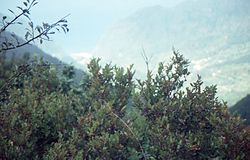Vaccinium padifolium
| Vaccinium padifolium | |
|---|---|

| |
| Scientific classification | |
| Kingdom: | Plantae
|
| (unranked): | Angiosperms
|
| (unranked): | |
| (unranked): | |
| Order: | |
| Family: | |
| Genus: | |
| Species: | V. padifolium
|
| Binomial name | |
| Vaccinium padifolium J.E. Sm. ex A.Rees
| |
Vaccinium padifolium (Madeira blueberry) is very common at elevations between 800 and 1,700 metres (2,600 and 5,600 ft). It grows mainly in crevices and exposed slopes and mountain plains. Fruits are used in preserves. It is endemic to the islands of Madeira and Porto Santo, Portugal.
Description[]
It is a semi-evergreen scrub to small tree 1.5–6 m tall. New branches are generally reddish and pubescent. Leaves are often flushed dark red in autumn 2.5–7 × 1–2(2.5) cm, oblong to elliptic, acute to acuminate, petiole short, pubescent. Calyx 3–4 mm, with five short, broad lobes up to 1.5 mm. Flowers on curved pedicels in erect, axillary, bracteate racemes. Corolla, 7–10 mm, globose to campanulate, the lobes very short. There are often five broad rose stripes on the white corolla. Berries up to 12 × 10 mm, ripening blue-black.
Chemistry[]
The blue color of the berries is due to anthocyanins ( and ).[1]
Picture gallery[]

Vaccinium padifolium shrubs on a slope in front of a view of São Vicente in Madeira, Portugal.

Vaccinium padifolium bushes on a slope in front of a view towards São Vicente.

Vaccinium padifolium.

Vaccinium padifolium, flowers.

Vaccinium padifolium.

Vaccinium padifolium, autumn leaves.

Vaccinium padifolium, over 2 m high shrub.
References[]
- ^ Anthocyanin trisaccharides in blue berries of Vaccinium padifolium. Luis Cabrita, Nils Åge Frøystein and Øyvind M. Andersen, Food Chemistry, Volume 69, Issue 1, April 2000, Pages 33–36, doi:10.1016/S0308-8146(99)00230-7
- Flora Endémica da Madeira, Roberto Jardim, David Francisco, Múchia, Publicações, 1ªed, 2000, Portugal, ISBN 972-8622-00-7
- J. R. Press and M. J. Short, Flora of Madeira, ISBN 9781 898 29880 9, 2001, Natural History Museum, UK,
| Wikimedia Commons has media related to Vaccinium padifolium. |
- Vaccinium
- Endemic flora of Madeira






